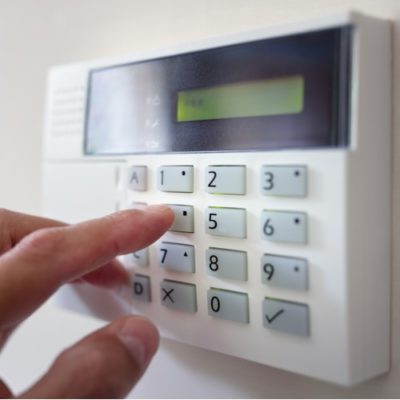The trauma of home invasion is more about losing your sense of privacy and safety than it is about losing your stuff.
After a home invasion or burglary, you may feel anxious, angry, and violated. But it doesn’t have to be like this forever. Recovery is in sight when you take the steps to restore your sense of security and find your stolen items.
How to handle the trauma of home invasion
1. Ensure everyone’s safety
The first step to take after invasion occurs is to make sure everyone’s safe. While burglars generally choose homes without anyone in them, someone may have been around when it happened.
Check on kids, spouses, or roommates who may have been present when the intruder entered. Make sure they’re unharmed, and get them medical attention if they are.
Even if they’re physically safe, stay with them and listen to their experience of the traumatic event. This will comfort them and give you important details for a police report.
2. Take notes and pictures
After the trauma of home invasion, staying focused is tough. But all the practical stuff like noting the time, date, and details of the break-in can help the authorities recover your possessions faster or lead to an arrest.
Before you call for help, gather some data. Start by taking pictures of any damage to your house. Look for signs of forced entry like broken locks, glass, or any damaged furniture or possessions.
Note anything missing and estimate its value. Things like heirlooms may not be easy to replace, but you might be able to get reimbursed for their value.
3. File a report with police and insurance
Once you’ve collected all the details, call the police. Giving the authorities information like dates, times, lists of items stolen, and photos of the scene or possessions will strengthen the investigation. This data also helps them piece together incidents if there have been other break-ins in your neighborhood. The police are here to help you, so the more details you give, the better the outcome.
After filing a police report, the responding officer will look through the details. That’s why photos, timelines, and any other information you can give law enforcement is crucial. If violent crime was involved, you may hear from a detective or the sheriff’s office for further information.
Many home and renters insurance policies cover vandalism and theft (to an extent). The details will depend on your policy, but you could be compensated or get help from your insurance provider. After you’ve filed the police report, call and make a claim to find out if you’re covered.
4. Talk about it
After the trauma of home invasion, post-traumatic stress (PTSD), anxiety, and other effects aren’t always immediately obvious.
It takes time to process something as traumatic as home invasion. You may feel like your space and privacy has been violated. You may even feel unsafe in your home. Talk to friends and health care professionals about the fear and memories to start healing.
Stay with friends or family
If you don’t feel comfortable in your home just yet, stay with friends or family for a couple of nights. It won’t solve the problem completely, but it’s a good step for sorting your thoughts and staying in a safe place to talk about it.
Seek counseling
Check with your insurance or employee assistance programs to see if you have access to mental health benefits. You can also find online and over-the-phone grief or trauma counseling for a discounted price. A professional counselor can help you process the psychological impact of the experience.
5. Prevent another incident
Part of the healing process is taking measures to prevent another incident. Strengthening your home security can make you feel safer after the experience too. You can shed the stress knowing you’re prepared and safe.
Make your home look occupied (even when it’s not)
Intruders don’t want to get caught, so they tend to break in during the day while families are at school, work, or on vacation. Outsmart the baddies by making your home look occupied with tricks like smart outlets to keep the TV or lights on while you’re away.
Improve your locks and doors
According to the most recent FBI data, over half of the burglaries in 2018 (56.7%) involved forcible entries. The rest were unlawful entries (36.7%).1 Reinforcing your doors and locks can make forced and unlawful entries harder for intruders to complete.
Replace your locks with smart locks or add a deadbolt to strengthen the door. You can also replace the door with a heavy security door that’s tougher to pry or kick down.
Install a camera, sensors, or security system
Install new security and surveillance equipment to keep track of the comings and goings in your home. Don’t worry, you don’t have to turn your home into a fortress to feel safer—adding just an outdoor camera or a few sensors can work for smaller homes.
A full-fledged home security system can also be enough to scare off potential intruders. They come with enough sensors to cover every entrance in your home and loud sirens to make burglars think twice about hitting your house. The best security systems connect to an app on your phone that lets you monitor your home whether you’re there or not. If you opt for a security system, choose one with professional monitoring for an extra layer of backup.
Professional monitoring connects your system to a center of trained pros who can help you respond to emergencies like break-ins, fires, and medical emergencies. They connect you with first responders quickly and can talk you through the emergency if you start to panic.
Compare the best home security systems
| Brand |
| Lowest Monthly Monitoring Price |
| Starter Equipment Price |
| Contract Required |
| Installation |
| Smart Home Compatibility |
| Learn More |
| Read Review |
| Best Overall | Smart Home Pick | No-Contract Pick | Most Well-Known | Techie Pick |
|
|
|
|
|
|
| $44.99 | $29.99 | $14.99 | $27.99 | $19.00† |
| $0.00* | $599.00 | $229.00 | $0.00** | $399.99 |
| X No |
X No˄ |
X No |
✓ Yes |
X No |
| DIY | Pro | DIY | Pro | DIY |
| Amazon Alexa Google Assistant Z-Wave |
Amazon Alexa Google Assistant Z-Wave |
Amazon Alexa Google Assistant |
Amazon Alexa Google Assistant Z-Wave |
Amazon Alexa Google Assistant Z-Wave |
| View Packages | View Packages | View Packages | View Packages | View Packages |
| Read Review | Read Review | Read Review | Read Review | Read Review |
Info current as of 07/13/2020. Offers and availability may vary by location and are subject to change.
*$0 due up-front with consumer financing.
**With $99 installation charge and new monitoring agreement. Early termination fee applies. See SafeStreets.com for full offer details, terms, and conditions.
˄No-contract options available with outright equipment purchase.
† Professional monitoring provided by Brinks Home Security.
Post-burglary recovery FAQ
How often do burglars get caught?
Unfortunately, not often. One study found that 80% of the homes surveyed were empty when the incident happened. Most of the homes in this study were hit between 12:00 p.m. and 4:00 p.m. while most families are at work or school.2 This makes it difficult to make an arrest without video footage or fingerprints.
Will I get my stolen items back?
It could happen, but it’s not likely. The FBI found that only 28.4% of stolen property is recovered.3 Learn more about recovering lost or stolen items to boost your chances.
How can I feel safe again after a home invasion?
Recovery time and methods vary from person to person, but preventative measures are the best way to recover after post-traumatic stress. Participating in the neighborhood watch, installing a home security system or camera, or improving locks and doors around your home are ways to start the healing process.
Sources
- Federal Bureau of Investigation, “2018 Crime In The United States Burglary”
- University of North Carolina at Charlotte Department of Criminal Justice and Criminology, “Charlotte Residential Burglary Victimization Survey: Exploring Post-Burglary Adaption from a Victim’s Perspective”
- Federal Bureau of Investigation, “2018 Crime In The United States – Property Stolen and Recovered, Table 24”
The post How Your Family Can Recover After a Burglary appeared first on SafeWise.
Article source here: How Your Family Can Recover After a Burglary


No comments:
Post a Comment